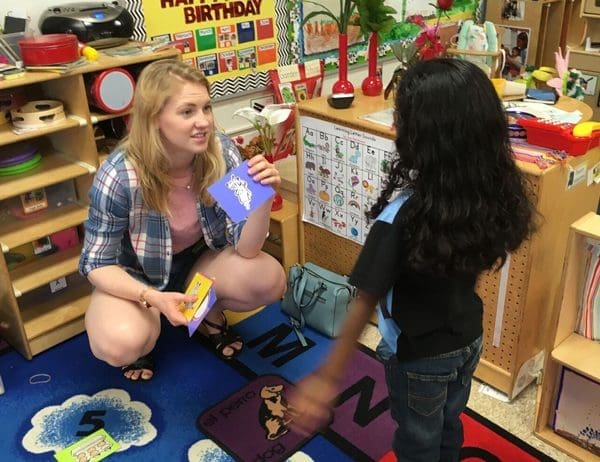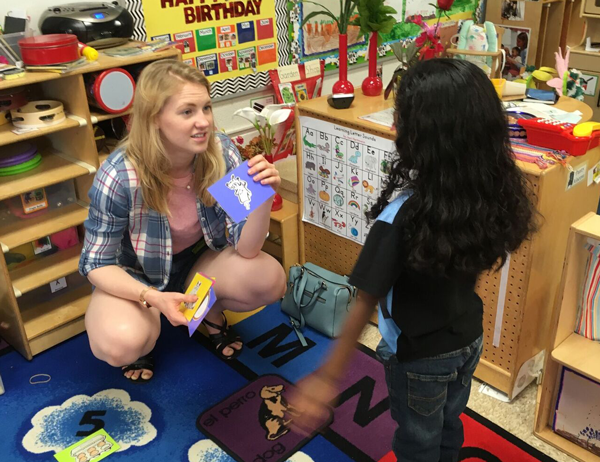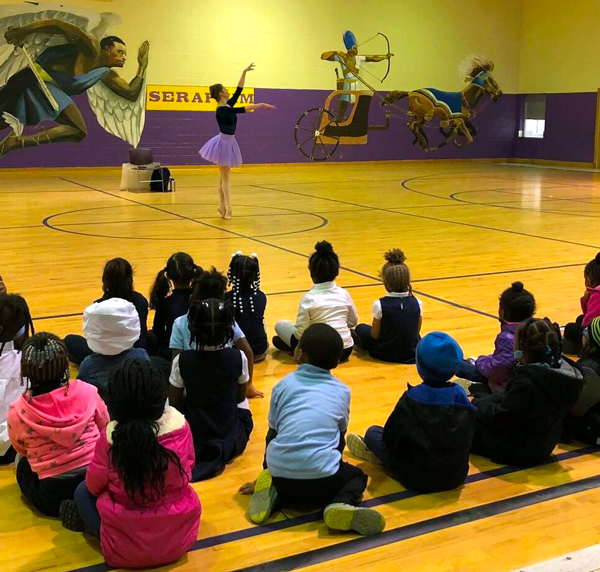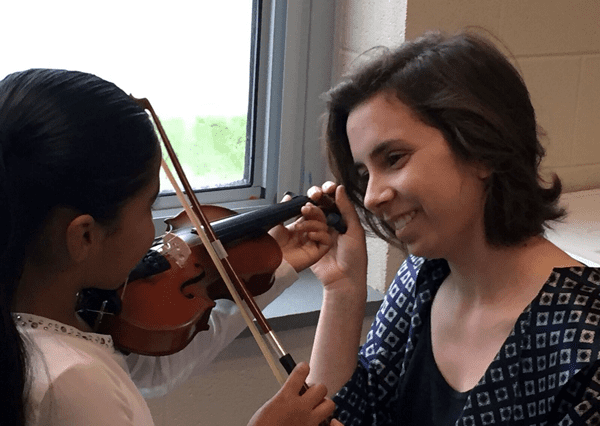
In Winston-Salem, the R.J. Reynolds stacks that once billowed grand plumes now stand smokeless. The company’s Bailey Power Plant, which had fueled manufacturing processes and filled the massive chimneys with particulate, became obsolete when the tobacco industry dwindled. In 1997, the facility was shuttered.
But Camel City isn’t a ghost town by any stretch of the imagination. The dual brick and mortar giants, which still dominate the skyline, aren’t gloomy relics of a long-gone industrial heyday. The Bailey Power Plant thrives, but in a different way. It provides a grand backdrop against which the city’s vibrant, dynamic activity unfolds.
Under their shadow, yogis in Bailey Park practice sun salutations as the summer days close. During Winston-Salem’s annual Gears and Guitars festival, the peloton whizzes past the stacks. Nearby, young professionals sip cocktails and craft beer. Live music reverberates off the bricks. Throughout the year, families share food truck nibbles and gaze up at the magnificent masonry.
Following some economic hard times, the city has bounced back in a spectacular way. Art powers much of this revitalization. Winston-Salem is certainly home to plenty of new high tech, medical, and pharmaceutical industries. But art makes the city hum. Gears alone don’t keep Winston-Salem on the move. Creativity drives technical and industrial innovation; it is a powerful contributor to the city’s unique sense of community; and it has transformed Forsyth County into a destination. The two UNC System institutions in Winston-Salem have played no small roll in influencing its rebrand as the “City of Arts and Innovation.”
Not surprisingly, then, when Winston-Salem State University (WSSU) and the University of North Carolina School of the Arts (UNCSA) submitted plans to enhance community engagement efforts, art was central to each institution’s proposal. These engagement plans show how arts initiatives can go well beyond beautifying public spaces. Both institutions have established arts programs designed to have a tangible impact on health outcomes, student success, and overall well-being.
A System-Wide Call for Creative Solutions
During President Margaret Spellings’ tenure, the University has taken important steps to ensure that students are not the only beneficiaries of its work. Higher Expectations: The Strategic Plan for the University of North Carolina 2017-2022 calls for the University to “increase investment of time and resources in strengthening North Carolina communities.”

In pursuit of this goal, Higher Expectations directed each constituent institution to submit a plan for enhancing community engagement efforts. By October of 2018, System Office staff had received materials from each institution: 17 institutions, with 17 ambitious, unique, and deliverable plans to assist a North Carolina community or region in need.
“The UNC System depends on the support of every North Carolinian,” said UNC System President Margaret Spellings. “These institutional community engagement initiatives provide concrete examples of how the University gives back. Across the state, the UNC System works to ensure that every North Carolinian reaps the benefits of this mighty engine for prosperity. Our institutions drive the state’s economy in more ways than one.”
Some UNC System institutions will work to improve regional education outcomes. Others are dedicating resources to provide much needed health-care services in under-served areas. Still others are pursuing plans that will strengthen and revitalize economically distressed areas.
WSSU and UNCSA have both presented plans in which arts and arts education will play a significant role improving residents’ quality of life.
Artbeat: Performance Steadies the City’s Health Stats
Art keeps the city’s pulse thrumming. So, when WSSU presented a sweeping plan to promote equity and social justice in health-care delivery, treatment, and outcomes, it was only natural that performance would feature prominently in its strategy.
The university’s Health + Art (HeArt) Studio is housed in the Center for Design Innovation, a multi-campus research center “founded to generate knowledge across creative, disciplinary, and institutional boundaries.” Instituted in July 2018, HeArt Studio’s specific focus is to create research and programmatic opportunities that combine health and the arts.
Garrett Davis’ play Daddy’s Boys centers around a theme rarely treated in the theater: prostate cancer in the African American community. In using a fictional narrative to explore an uncomfortable topic, Davis’ work helps audiences develop strategies for tackling the fear and embarrassment the disease typically provokes.
Prior to the performance, WSSU’s School of Health Sciences provided free health screenings. This unusual “double-bill” made it convenient for those attending to get tested for prostate cancer and other medical conditions without having to sacrifice an evening’s entertainment.
The production drew an audience of over 900. This impressive number suggests the studio’s potential for reaching a vast audience and having a significant impact on the community’s overall health and well-being.
It also illustrates why partnerships between the university and the community are critical to any engagement effort. In the weeks leading up to the play, WSSU coordinated with United Health Centers and the local faith community to sponsor a series of lunch and learns and round table discussions. Representatives from the studio and cast members even marched in the university’s homecoming parade. Not only did these events provide an educational forum on prostate health; they also helped promote the play as an important tool for learning more.

Future HeArt Studio events will address four key focus areas: violence, healthy relationships, chronic disease, and caregiver education.
Sisters at Heart, a follow-up play focused on congestive heart failure, is already in the planning stages, but events at the studio won’t be limited to theatrical performances. One program in the works will teach caregivers how to use music and dance to restore their own emotional and physical reserves. Drumming circles will help facilitate healing processes related to anxiety and violence. Paint-and-learn activities are also on the horizon, along with activities structured around spoken word and dance.
“Every program will be different,” said Dr. Melicia Whitt-Glover, executive director of WSSU’s Center of Excellence for the Elimination of Health Disparities (CEEHD) and the faculty lead for HeArt. “Our mission is to establish interinstitutional, interdisciplinary, and inter-sectoral programs that bring faculty, students, and the community together to find multi-disciplinary solutions to health problems. The studio will provide space, support, and resources for partners across the community to develop immersive, interdisciplinary research projects that combine health and related education with artistic expression.”
The HeArt Studio is co-led by Dr. Tanya Walker, faculty member in WSSU’s Department of English.
“Winston-Salem State has long been an opportunity gateway for residents of Winston-Salem,” said Elwood L. Robinson, WSSU’s chancellor. “With innovative research programs like the HeArt Studio, the university is taking a leadership role to help improve our community. Few universities across the country are more dedicated to improving the lives of those in their communities.”
HeArt Studio is only one spoke of the CEEHD’s multi-pronged approach to addressing these issues. The CEEHD will also continue its grant activity in support of community-based participatory research. These grants will fund efforts to tackle local health-care priorities, including obesity and diabetes treatment and prevention.
In addition, the CEEHD has expanded the services and hours of its Rams Know H.O.W. (Hands On Wellness) mobile unit. Since it launched in 2011, the clinic has served over 10,000 uninsured or underinsured residents. WSSU School of Health Sciences faculty, staff, and student volunteers all work to offer preventative health screenings, acute medical care, immunizations, and medication consultations. This work depends on several alliances between the CEEHD and community organizations, including United Health Centers, Housing Authority of Winston-Salem, and the local Southside Discount Pharmacy. WSSU is the only HBCU operating a mobile health clinic, and, in 2017, the Mobile Health Clinic Association recognized the university with an “excellence” award for its work.
Arts Education Works Overtime: Improving Student Success Across the Spectrum
With the help of UNCSA’s ArtistCorps participants, third- and fifth-graders at Brunson Elementary are busy making movies.
This might sound like fun and games, but making films is hard work, which requires skill, discipline, and vision. More than that, for these elementary school students, it requires an understanding of rainforest trophic levels and other bionetworks.
As these UNCSA ambassadors lead this weeks-long immersive learning exercise, they share their own expertise with Brunson’s students. The process begins with the dissection of professional films. Brunson’s students learn to recognize the tools filmmakers use to inform, entertain, and persuade.
After a few weeks, the third and fifth graders are ready to begin building their own portfolios. Teams receive scientific content. Then, each of these mini production units plots its own creative course. How will their film organize this information? What images will they use? Will the film have sound? The process culminates with a film festival, where groups from eleven different classrooms share their work.This learning opportunity connects music, drama, script writing, math, visual arts, science, technology, research, and English language arts. By immersing themselves in this process, these budding cineastes develop an understanding of films, filmmaking, and natural ecosystems.
This time-intensive engagement effort is just one way that ArtistCorps pursues its central mission to utilize “arts instruction, arts integration, and arts exposure to improve educational outcomes in public schools and community agencies.”
UNCSA’s faculty and administrators stress that their community engagement is driven by the long-term goal to improve student success. As the institution’s engagement plan explains, art instruction helps young learners to “deepen their academic comprehension and social-emotional skills.”
For this reason, it should be an integral component of any rigorous academic program.
Another ArtistCorps pilot initiative targets Spanish-speaking pre-K students so that, by the time they reach kindergarten, they are better prepared to succeed in their primary school lessons on reading and writing English.
Mastery of reading and writing doesn’t come easily for many of the students at Easton Elementary. Easton Elementary is a Title I school, with most students coming from low-income families. Many are non-native speakers.
One of the most significant hurdles facing Spanish-speaking students is that they can’t hear many of the sounds so integral to general American speech. Language acquisition hinges on audio. If a student has trouble processing foundational linguistic sounds, then reading, writing, and speaking become herculean tasks.
As a voice faculty member for UNCSA’s drama program, Ann-Louise Wolf is an expert on helping actors listen to and mimic different accents. Wolf has devised a program that reformulates her backstage-practice techniques for use in pre-K classrooms. Utilizing a combination of visual and kinesthetic instruction, she helps young listeners register and repeat the nuances of the most basic consonant and vowel sounds many of us take for granted. Her innovative approach helps these non-native speakers develop the inventory of sounds at the foundation of our speech.

These are just two of the ArtistCorps initiatives. Currently, ArtistCorps enlists the help of 30 students, four recent graduates, two graduate assistants, and four faculty members. Its efforts reach students on every level of the p-12 spectrum. And this year, one member is piloting a program for the elderly population.
Crucially, each ArtistCorps program is designed to be a sustained effort. Whether they are teaching music, dance, filmmaking, creative writing, or visual arts, ArtistCorps members work with the same cohort of learners on a daily to bi-weekly basis. By making art instruction routine and regular, these programs ensure that lessons build on one another. Knowledge and skills accumulate.
ArtistCorps will expand over the course of the next three years, recruiting more members, ramping up service to preschoolers, and increasing its engagement with Forsyth County’s elderly population.
“Arts involvement in and out of school has been positively correlated with academic achievement, regardless of socioeconomic status,” explained UNCSA Chancellor Lindsay Bierman.“One way we connect to our local community is through the ArtistCorps program, which utilizes the arts in serving young learners and elders, particularly in the economically depressed areas surrounding UNCSA. This program offers our students and recent graduates the opportunity to meaningfully connect their training in the arts with ongoing service that is curated to build knowledge in arts while providing creative expression, building academic and social skills, and boosting self-esteem.”
Art Builds, Lifts, and Sustains Communities
Today, the once-bustling tobacco processing hub has become a vibrant research corridor. At the Wake Forest Innovation Quarter, public-private investment drives cutting edge research in biomedical science, information technology, creative digital arts, prosthetics, and more. In these repurposed tobacco warehouses and factories, both WSSU and UNCSA lead vital research initiatives, working side-by-side with other academic institutions and private businesses. The R.J. Reynolds stacks stand tall in the Quarter, intentionally left behind as iconic symbols of Winston-Salem’s ever-evolving industry and culture.
Winston-Salem has certainly adapted to changing times. Still, not everyone can easily keep apace. These community engagement plans demonstrate the UNC System’s fierce commitment to ensuring that disadvantaged members of the community don’t get left behind.
In the coming weeks, more information about all of the institutional community engagement plans will be made available across various outlets, and each institutional plan will be posted on the UNC System website.
“At UNCSA, we frequently hear from students that ‘art saved my life,’” said Chancellor Bierman. “It’s not hyperbole. Research has shown that the arts contribute to healing and that creativity improves well-being. Particularly among economically disadvantaged students, creative expression has been instrumental in building self-esteem.”